Milford Sound or Doubtful Sound – which one should you choose?
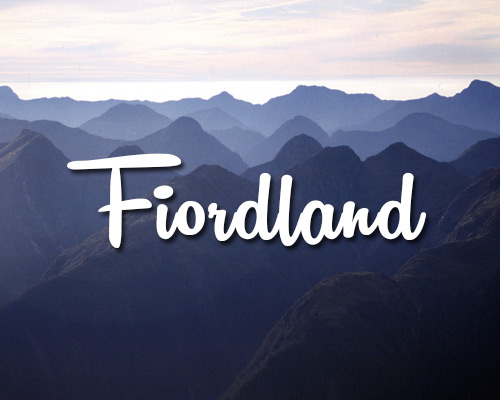
Fiordland
Are you longing for some better travel stories? What if you could tell your friends that you’d just got back from visiting the most beautiful place on earth? ‘That’s a bold claim!’ they might say – but it’s a claim you can make with a straight face after a trip to Fiordland in New Zealand. It’s an untouched natural beauty, most famous for its crown jewels – Milford Sound and Doubtful Sound, two spectacular fiords that carve their way inland with waterfalls cascading down their sheer granite walls.
Sound good? Thought so! But first you’ll want to decide whether you head to Milford Sound or Doubtful Sound – either one will be the adventure of a lifetime, so your choice may come down to how much time you have to explore. Our ultimate guide to the has all the information you need to prepare for a journey to the 8th wonders of the world!
The differences between Milford Sound and Doubtful Sound
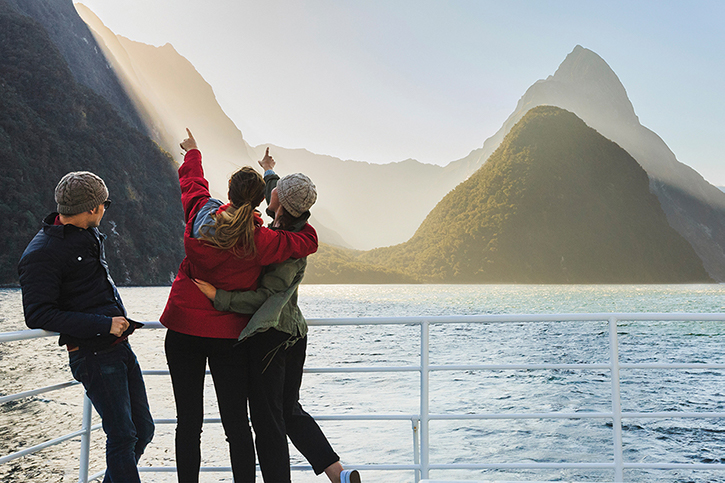
Milford
At first glance, it might seem like Milford Sound and Doubtful Sound are much the same apart from slightly different names – they’re both beautiful fiords (although technically fiords, the original name ‘sound’ stuck), and they’re both located in Fiordland National Park – but the reality is they’re actually very different from one another. So you can decide which one is the better choice for you, let’s have a look at what makes these natural wonders different from each other, and how that affects your decision on a practical level.
1. How accessible are they?
Milford Sound can be accessed by road or by air, making it significantly easier to get to than Doubtful Sound, which can only be accessed via boat from Te Anau. With more flexible travel options, it’s possible to see Milford Sound in as little as half a day, whereas Doubtful Sound is a minimum full-day trip, with the overnight cruise our recommended option. There’s really no competition in terms of accessibility: if you want to experience the beauty of the fiords in as little time as possible, Milford Sound is the choice for you.
2. Are they the same size?
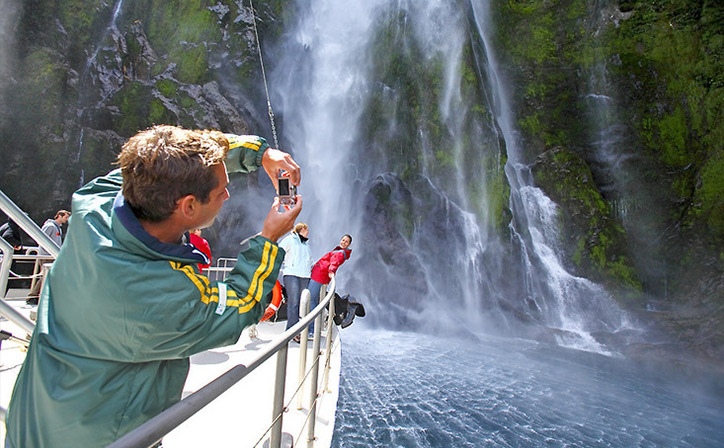
Milford Sound Nature Cruise
No. Doubtful Sound is actually much larger than its more famous brother! At over 40 kilometres long, Doubtful Sound is almost three times longer than Milford Sound, which is ‘just’ 15 kilometres from tip to tip. Doubtful Sound also takes the top spot as New Zealand’s deepest fiord, with water depths in excess of 420 metres – that’s 1380 feet in Imperial units, or four soccer pitches for you sport fans. Due to the larger size of Doubtful Sound, we recommend the overnight cruise option as it provides the necessary time for you to explore the massive area properly, you’ll also learn a ton about the fiord and its history from your experienced guide. Follow the link to learn more about the Doubtful Sound Overnight Cruise.
3. Which one is busier?
Milford Sound regularly gets over 500,000 visitors per year, making it the most popular tourist destination in New Zealand. By comparison, Doubtful Sound receives a much lower volume of visitor traffic, due mainly to its more isolated location and restricted access. If you’re looking for tranquillity, Doubtful Sound is your friend – the Māori name, Patea, translates to ‘place of silence’; it’s a place where the lack of noise from planes and other boats means total peace and quiet, and the soothing sounds of waterfalls and wildlife take centre stage.
4. Which one is more affordable?
With a bigger range of transport options and tour-times, Milford Sound is the more affordable choice. Overnight tours to either fiord incur a higher cost, but include meals onboard the boat, plus more options for exploring the waters, like guided kayak trips… so the overnight tours pack a ton of value! A great entry level option is the Milford Sound Coach & Scenic Cruise Tour, which gets you from Queenstown to Milford Sound and back in just one day. Other options include flying the return leg home for a shorter journey or flying both ways – the quickest option.
Learn more about Milford Sound / Piopiotahi
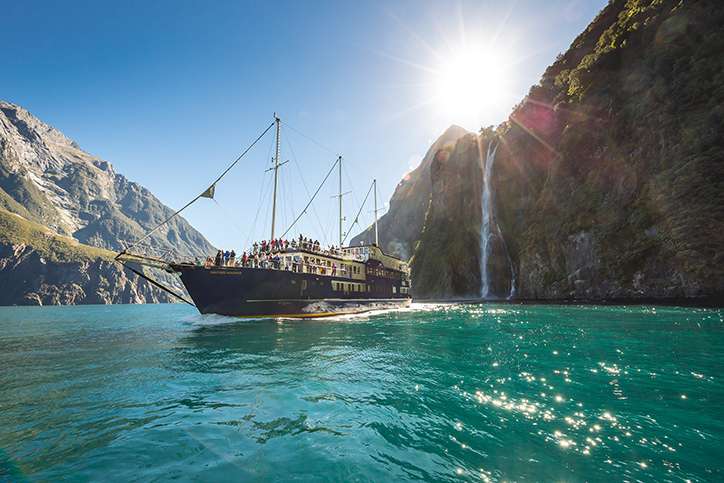
Milford Overnight Cruise
The History of Milford Sound
Initially overlooked by foreign explorers including Captain James Cook due to its narrow entrance and sheer cliff walls, the fiord was first discovered by Europeans in the early nineteenth century, when a Welsh sailor named John Grono discovered the sound, naming it Milford Sound, after the Welsh estuary town Milford Haven. Prior to Grono’s arrival, local Māori had been present in the area for many hundreds of years, travelling to the sound to fish and hunt. The Māori name, Piopiotahi (meaning ‘a single piopio’), originates from an old Māori legend about the adventurer Maui; it is said that when Maui died, a single piopio (a long-extinct native bird) flew to Milford Sound in mourning.
Climate & Geology
One thing to know about the weather at Milford Sound? It rains. A LOT! In fact, it’s recognised as one of the wettest inhabited places on the planet – rainfalls in excess of 10 inches have been measured in just a single day. But don’t let the high chance of rain deter you – unlike most places, Milford Sound actually becomes more beautiful, more spectacular after rainfall – this is when natural waterfalls spring to life, tumbling their way down the cliff walls, some with falls nearly a kilometre long. The waterfalls are the magic of nature at work, and the reason why people come from all over the world to see Milford Sound. Make sure you pack a good raincoat, because this is one rainy day you’ll be looking forward to!
One of the most notable features of Milford Sound is the black coral which grows under the water. Normally found in the deep waters of the ocean, it grows in the waters of Milford Sound at depths as shallow as 10 metres, thanks to the unique makeup of the water in the fiord. As rainfall runs down through the forest, it collects tannins from the trees, making it a dark black-brown colour. As this dark rainwater settles on top of the saltwater in the sound, it blocks sunlight from reaching the bottom, creating the perfect conditions for black coral growth!
Wildlife of Milford Sound
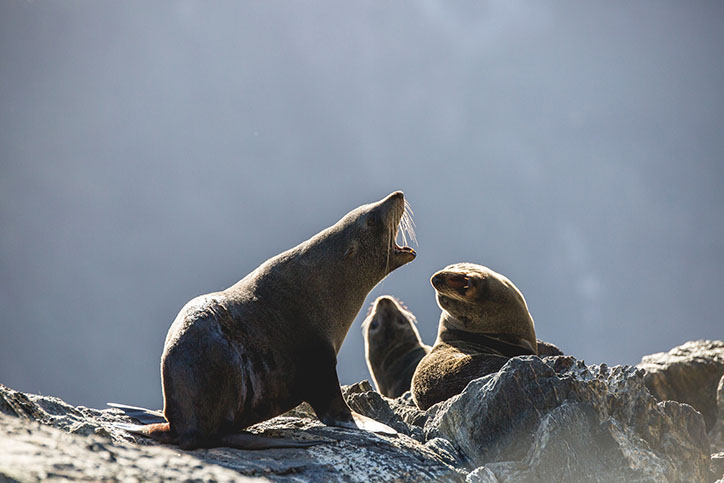
Fur Seals at Milford
Milford Sound is home to an array of marine mammals, birds and native trees. Fur seals and bottlenose dolphins are permanent residents, with healthy numbers of both found all year round – and there’s few places on earth where you’ll see dolphins leaping and playing so close to shore. Whales have been spotted in the waters of Milford Sound on rare occasions, though they are infrequent visitors.
Penguins can be seen in Milford Sound, the most commonly found are the Little Blue penguins, but lucky travellers may also get to see the Fiordland Crested Penguin; a very rare endangered species found nowhere else in the world. You can spot the Fiordland Crested Penguin by looking for its distinctive blonde streaks and orange beak.
The Blue Duck is another rare species which can sometimes be seen, along with more common birds like shags, shearwaters and Kea. The critically endangered Kakapo and Takahe species also live here, although their shy nature and small numbers mean they’re very rarely sighted.
About your cruising vessel – The Milford Wanderer
The Milford Wanderer is a purpose-built boat, styled like a traditional trading scow but with a contemporary fitout inside. There’s a range of cabins (private or shared), a fully licensed bar, a dining room serving three-course meals, and the highlight – a spacious outdoor observation deck – we reckon this is where you’ll spend most of your time!
Learn more about Doubtful Sound / Patea
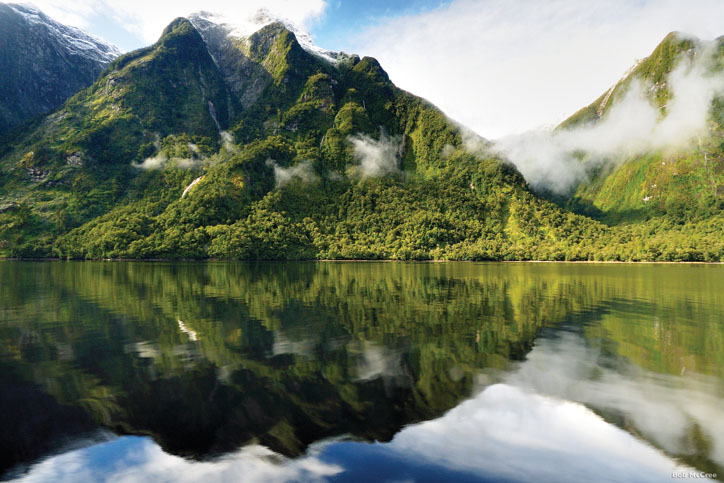
Doubtful Sound
The History of Doubtful Sound
First named ‘Doubtful Harbour’ by Captain Cook upon seeing the narrow and risky entrance to the inlet in 1770, Cook decided against travelling inwards due to treacherous conditions, and the fiord was later settled by Spanish explorers in 1793. The fiord was later renamed Doubtful Sound by whalers and sealers, who established extensive operations which became so rampant that they threatened to extinguish the population of Fur Seals around New Zealand’s southern coastline. As the seal-skin trade became increasingly destructive a total ban was introduced in order to protect New Zealand’s seals. Later, farmers and gold miners arrived in the area, and there was a short-lived gold rush in the late 19th century which lasted just one year. In the 20th century, 16 lives were lost in the construction of the Manapouri Power Station, which harnesses energy generated between the waters of Lake Manapouri and Doubtful Sound. Manapouri is New Zealand’s largest hydro power station.
Climate & Geology
Much like Milford Sound, Doubtful Sound experiences huge rainfalls – often more than 200 rainy days per year! As weather patterns can turn quickly, we advise you to pack warm and rainproof clothing to ensure your comfort whatever the weather. Like the other fiords in Fiordland, Doubtful Sound is also filled with an unusual mix of fresh water and salt water layers that do not mix together. The top 10 metres or so are fresh water which is dark in colour due to forest floor runoff, meaning the seawater layer underneath is exposed to very little sunlight, and as a result many deep-water ocean species can be found here.
The rock formations found in Doubtful Sound typically consist of speckled granite, slate and limestone, with origins tracing backs as far as 450 million years!
Wildlife of Doubtful Sound
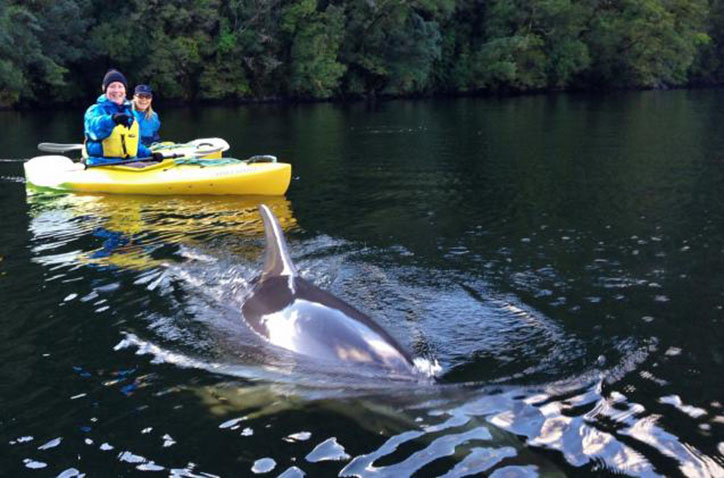
Dolphins at Doubtful
The local flora and fauna in Doubtful Sound are mostly the same as those found in Milford Sound – a pod of around 60 bottlenose dolphins are permanent residents, along with fur seals, Blue Penguins and the rare Fiordland Crested Penguin. Look out for Fiordland Crested Penguins on the Rolla and Shelter islands, where they are most likely to be found during breeding season (July – November). Native birds thrive in this peaceful environment and their songs carry far across the silent waters. One of the biggest differences between Milford Sound and Doubtful Sound is the noise level, due to the low volume of boats and total lack of planes, Doubtful Sound is named the ‘place of silence’ – forget about motor noises, the birdsong is your only soundtrack in Doubtful Sound.
The Fiordland Navigator – Doubtful Sound’s custom-built cruiser
Like the fiord itself, Doubtful Sound’s boat is bigger than its sister vessel in Milford Sound, with capacity to sleep 72 guests in total comfort in private or shared cabins. There’s a full bar and saloon-style dining room, plus an observation deck of course. The boat also carries kayaks for those wishing to embark on their own mini-adventure – highly recommended!
Even more things to do in Fiordland
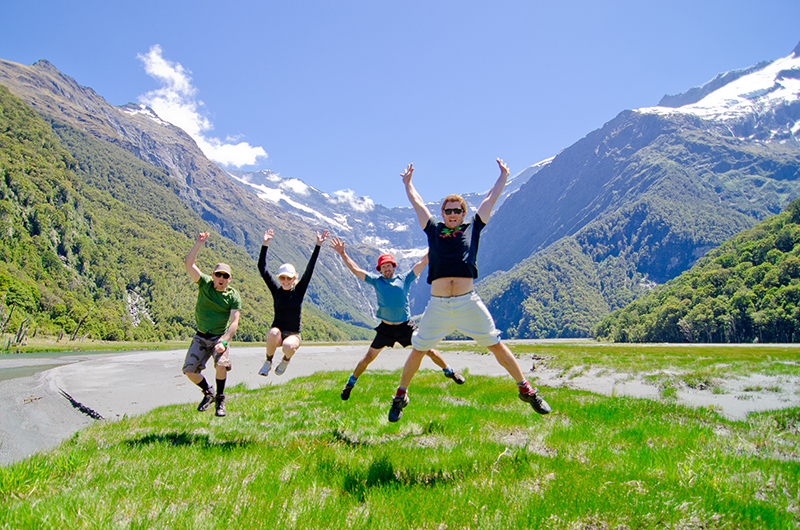
Summer-Time Hike
Want to see more of Fiordland while you’re there? Here are some of our picks for the best things to do:
- Incredible walking trails: Milford Track, Hollyford Track, Kepler Track, Mirror Lakes Walk.
- Jet boating – Wairaurahiri Jet or Fiordland Jet.
- Stay at the amazing Fiordland Lodge – world-class food, luxury rooms and views to die for.
Pick your cruise and get ready to experience the magic of Fiordland National Park!
What’s the most beautiful place you’ve ever visited? Let us know in the comments below 👇

No comments